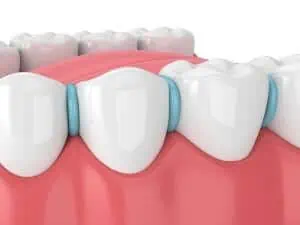For people with crooked or misaligned teeth, orthodontic braces are a great solution for straightening them out. And though most of us are familiar with what braces are, many don’t know that braces function properly with the help of spacers for braces.
Understanding intricacies like spacers can help you obtain a transparent picture of the procedure involved with getting orthodontics. And that can make the whole process a little less daunting.
In this post, we’re going to fill you in on all there is to know about teeth spacers. We’ll offer the answers to questions like:
- What do spacers do for your teeth?
- Are spacers for braces painful?
- Can you eat with them?
- What happens if they fall out?
Let’s dive in.
In This Article
What are spacers for teeth?


Orthodontic separators, commonly known as tooth spacers, are rubber bands or orthodontic metal bands measuring about a centimeter in diameter to make more room before getting braces. They are typically placed between the molars (back teeth), or between specific front or middle teeth, to create space before braces are fastened on. A patient may have one to eight spacers installed before braces are fitted.
More often than not, a tooth spacer is used if the patient’s teeth are too close together. To secure it in place, the orthodontist stretches it and presses it firmly between the teeth with a word of caution that it must not be picked at or it may fall out.
Typically, dental spacers are secured between teeth a week or two before braces are put in. This time is enough for the molars to move sufficiently far apart. The gaps, or spaces, that spacers create are required for brace appliances like molar bands or expanders to be fitted afterward.
The indications for using a separator or spacer typically involve:
- Creating space for orthodontic band placement in traditional orthodontics or for the insertion of an orthodontic appliance.
- Creating space for crown preparation on inaccessible teeth or facilitating eruption of impacted molars.
There are different types of separators that can be used:
- Brass Wire: It is historically used and it is very uncomfortable as it encircles the entire crown of a tooth. It is also placed for approximately 5-7 days.
- Latex Elastics or Elastometrics separators: It is typically worn for 1-2 weeks, and is sized to open contact without being easily displaced. Latex should be avoided in patients who have a history of or are at risk of developing an allergy to it.
Separators can be of various shapes (doughnut or circular, dumbbell and c-shape), have arm attachments to prevent gingival submersion, and vary in the amount of space created. They typically range between 0.337-0.317 mm (NEET springs and Elastometrics, respectively) and 0.223 mm (brass wire separators).
Concerns with separators
- It primarily involves displacement and submersion into soft tissue, making removal during band placement appointments more difficult.
- Patients may require local or topical anaesthetic during removal.
- Elastometric separators that have become dislodged or submerged in soft tissue should be radiographed before attempting removal to ensure that they are still present and that the appropriate appliance is used to access the spacer.
Orthodontists or dentists may prescribe or recommend specific mouthwashes during spacer placement if necessary. This may be done if there is significant concern about oral hygiene and the potential for plaque accumulation or gingival irritation.
In the following video, Dr. Williams explains why he uses spacers for his patients, and how they differ from molar bands.
Are orthodontic spacers painful?
Most people experience some pain or discomfort from spacers for teeth. After all, they're putting pressure on the teeth and forcing them to move quite quickly. Depending upon how much space a patient has between their teeth, the degree of discomfort that spacers cause may differ:
- For people with relatively small or no space between their teeth, braces spacers can cause irritation in the nerves which may result in constant, but bearable pain.
- For some people, they may not hurt when initially applied but may start to ache after a while.
- Spacers can also become painful while chewing hard or chewy foods.
- In a few rare cases, spacers can dig into the gums causing swelling and occasional bleeding.
Usually, there’s nothing to worry about if any of the above happens. Orthodontists suggest that it is perfectly normal. Discomfort can be minimized by drinking cold drinks, eating ice cream, and taking over-the-counter pain relievers as prescribed.


After having spacers installed, a patient may feel like there's something stuck between their teeth, (because there is!) and they may be inclined to remove it. But trying to do so isn’t advised.
Attempting to dislodge or adjust spacers might lead to their falling out, which, although may relieve patients from the discomfort at that moment, will make the next step in the process tougher and more painful, or you may need to have the spacers fitted all over again.
Keep in mind, this is no excuse to stop brushing your teeth! Brushing doesn’t lead to the displacement of spacers. In fact, regular brushing is encouraged while spacers are in place.
How long do spacers hurt?
The level of discomfort caused by spacers differs for each patient. However, any initial soreness or pain from dental spacers being placed should fade away after about four to six hours. You may feel an aching that can get worse over the following day or two. If it happens, take solace in the fact that it is normal, and the pain will dissipate.
Can you eat with orthodontic separators in your teeth?


One of the most significant negatives of having spacers and braces is that you can eat only specific kinds of food once they’ve been put in place. Let's take a look at foods you should stay away from.
Which foods should be avoided?
- Chewy, sticky foods like caramel, taffy, and gum can stick on and around the braces and spacers.
- Hard foods that need more strength while chewing, like nuts, corn on the cob, and raw hard fruits can lead to the breaking of the wires in your braces. If you’re still on spacers, chewing hard foods can cause quite a bit of pain as well.
- If you eat something that’s exceptionally high in sugar and starch, it can cause plaque to accumulate around spacers and braces, increasing chances for decay.
This last reason is also why your orthodontist will advise you to continue a proper brushing routine once you get spacers or braces put in. It will not only help prevent staining and decay but also make sure food particles don’t get stuck in the new space that spacers create.
However, you may want to stay away from flossing between the teeth that have spacers. To be sure, ask your dentist.
The best kinds of food to stick to, if you have spacers or braces, are soft food like pasta, yoghurts, mashed potatoes and soup.
What should I do if separators for braces fall out?
If you’ve been following your orthodontist’s advice carefully, there are minimal chances of teeth separators falling out on their own. However, it might happen in rare circumstances. If it does, it may be because there is already enough room between your back teeth.
If your mouth spacers fall out on their own, or due to your attempt to alleviate pain, call your orthodontist immediately. They might want to call you in to check whether the spacers should be replaced.
Spacers for baby teeth
Although they have the same name, the spacers that your child might get when they begin to lose their baby teeth are quite different than orthodontic spacers.
Also called space maintainers, spacers for baby teeth are used when a child's baby tooth is lost prematurely, from being knocked out or from decay. These devices are used to stop the adjacent teeth from moving into the empty space and causing permanent teeth to come in crooked.
This is just one of the many reasons why it's so important to start bringing your child to the dentist at a young age, as early as their first birthday, or within six months of the first tooth eruption. You can read more about caring for your baby's teeth.
Losing baby teeth too early can put future smiles in jeopardy. This is why space maintainers serve such an important role. Space maintainers are dental devices for children that lose baby teeth before their adult teeth have erupted. Spacers help safeguard your child’s dental health as they grow. They also ensure that their future smile results as it should.
Not all space maintainers are the same. There are both removable and fixed devices. Removable devices are similar to an orthodontic retainer and can be removed for eating and cleaning. A fixed space maintainer is affixed to the teeth or gums around the vacated tooth space. They are often used for small children not quite old enough to care for a removable device. Choosing the right fit for your child’s needs is handled specifically by your dentist.
Dr. Catalina Botero, Li'l Sunshine Smiles Dentistry
Conclusion
What are they for? | What are the different types? | How long are they worn for? | Diet restrictions | Do they hurt? |
Creating space between teeth when there isn't enough space between your molars for molar band placement | Metal and rubber | 1–2 weeks before braces | Avoid foods that are chewy, hard and sticky | They can cause some pain or discomfort. To manage, apply cold and take OTC pain-killers |
To recap, spacers for braces create small gaps between teeth, usually molars, so that a molar band or other appliance can be placed as part of orthodontic treatment. Orthodontic separators are only in place for a week or two, but they can be quite painful, especially to begin with. It's a good idea to stock up on painkillers and soft foods to get you through the first few days.
Getting braces can be inconvenient, but knowing that your teeth will look more beautiful afterward makes it all worthwhile. Spacers form an essential initial step for many in completing the application of braces, and the more you know about them, the more you can anticipate what’s in store.
We hope this article has helped you feel more prepared for your teeth straightening journey.


FAQs
How long do spacers stay in?
You should wear spacers for your teeth for at least three to five days, or even up to a week. This allows enough space to be formed between your back teeth so that you have a smooth transition to molar bands when the time comes.
What's the difference between a molar band and spacers?
Molar bands and spacers may seem similar, but their functions are different. A spacer for teeth is placed around the molars before you get your braces to create more space for the braces to do their job. Then, when it's time to get braces, your spacers come out and a molar band will be placed around each of your back molars, in order to anchor your braces.
What happens after dental spacers are removed?
You will only have your separator for braces for 1-2 weeks before it's time to get them taken off. After your spacers are removed, they'll typically be replaced with a molar band for braces. Molar bands act to anchor your braces in place.
What do spacers for teeth cost?
Orthodontic separators are typically not charged separately because they are placed at the discretion of the dentist or orthodontist and are included in the overall cost of orthodontic treatment. The ADA does not have a separate orthodontic code for separator placement or removal. For billing purposes, providers may use pre-orthodontic visit code D8090.
Can spacers damage your teeth?
Spacers hurt little during the application; however, you may feel some sensitivity or experience inflammation. This is a sign that they are doing their work. You may feel like there's something stuck in your teeth and you may feel some soreness.
Do I need spacers before braces?
If your teeth, especially your molars, are very close together, you may need spacers. That's because when you get your braces, molar bands will need to be placed to anchor the braces in place. Rubber or metal brace spacers will help make room for those molar brands. Your orthodontist will be able to let you know if you need a spacer before braces.




